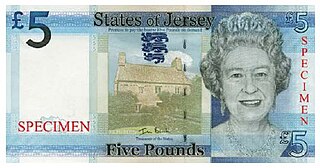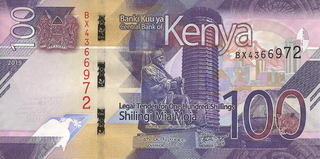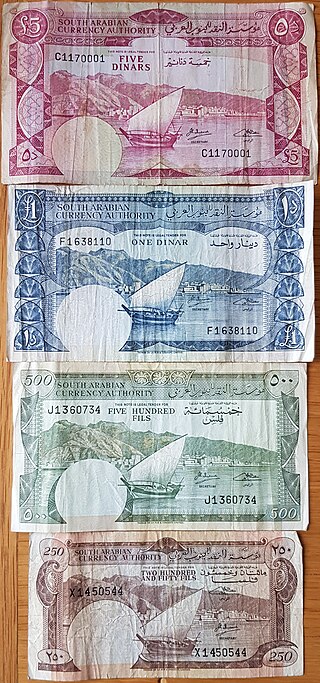Related Research Articles
The Kwacha is the currency of Zambia. It is subdivided into 100 Ngwee.

The kwacha is the currency of Malawi as of 1971, replacing the Malawian pound. It is divided into 100 tambala. The kwacha replaced other types of currency, namely the British pound sterling, the South African rand, and the Rhodesian dollar, that had previously circulated through the Malawian economy. The exchange rate of the kwacha undergoes fixed periodical adjustments, but since 1994 the exchange rate has floated. In 2005, administrative measures were put in place by Bingu wa Mutharika to peg the exchange rate with other currencies. Banknotes are issued by the Reserve Bank of Malawi. In May 2012, the Reserve Bank of Malawi devalued the kwacha by 34% and unpegged it from the United States dollar. The currency was further devalued by 25% by the central bank in May 2022 followed by another 44% devaluation in November 2023 raising inflation rate in Malawi.
The leone is the currency of Sierra Leone. It is subdivided into 100 cents. As of 1 July 2022, the ISO 4217 code is SLE due to a redenomination of the old leone (SLL) at a rate of SLL 1000 to SLE 1. The leone is abbreviated as Le placed before the amount.
The pound is the currency of Guernsey. Since 1921, Guernsey has been in currency union with the United Kingdom and the Guernsey pound is not a separate currency but is a local issue of sterling banknotes and coins, in a similar way to the banknotes issued in Scotland, England and Northern Ireland. It can be exchanged at par with other sterling coinage and notes.

The dalasi is the currency of the Gambia that was adopted in 1971. It is subdivided into 100 bututs. It replaced the Gambian pound at a rate of 1 pound = 5 dalasis, i.e. 1 dalasi = 0.2 pound = 4 shillings.

The Fijian dollar has been the currency of Fiji since 1969 and was also the currency between 1867 and 1873. It is normally abbreviated with the dollar sign $, or alternatively FJ$ to distinguish it from other dollar-denominated currencies. It is divided into 100 cents.

The pound is the currency of Jersey. Jersey is in currency union with the United Kingdom, and the Jersey pound is not a separate currency but is an issue of banknotes and coins by the States of Jersey denominated in sterling, in a similar way to the banknotes issued in Scotland and Northern Ireland. It can be exchanged at par with other sterling coinage and notes.
The pound is the currency of the Isle of Man, at parity with sterling. The Manx pound is divided into 100 pence. Notes and coins, denominated in pounds and pence, are issued by the Isle of Man Government.

The shilling is the currency of Kenya. It is divided into 100 cents. The Central Bank of Kenya Act cap 491, mandated the printing and minting of the Kenyan shilling currency.

The pound was the currency of New Zealand from 1933 until 1967, when it was replaced by the New Zealand dollar. Prior to this, New Zealand used the pound sterling since the Treaty of Waitangi in 1840. Like the pound sterling, it was subdivided into 20 shillings each of 12 pence.

The pound was the currency of Southern Rhodesia from 1964 to 1965 and Rhodesia from 1965 until 1970. It was subdivided into 20 shillings, each of 12 pence.

The dinar was the currency of South Arabia and then South Yemen between 1965 and 1990. It was subdivided into 1000 fils (فلس). After Yemen's monetary unification on 1 July 1990, it was one of the two official currencies used in Yemen Republic until 11 June 1996.
The pound was the currency of the Gambia between 1965 and 1971. Gambia used the British West African pound until it issued its own currency on October 5, 1964. In 1971, the dalasi replaced the pound at a rate of £1 = D5. 1 pound was made up of 20 shillings, each shilling consisting of 12 pence.

The pound was the currency of the Union of South Africa from the formation of the country as a British Dominion in 1910. It was replaced by the rand in 1961 when South Africa decimalised.

The pound was the currency of Zambia from independence in 1964 until decimalization on January 16, 1968. It was subdivided into 20 shillings, each of 12 pence.

The pound was the currency of the Federation of Rhodesia and Nyasaland. It was subdivided into 20 shillings, each of 12 pence.

The pound was the currency of Southern Rhodesia. It also circulated in Northern Rhodesia and Nyasaland. The pound was subdivided into 20 shillings, each of 12 pence.

The pound was the currency of Fiji between 1873 and 1969. It was subdivided into 20 shillings, each of 12 pence.
New Zealand dollar banknotes are the banknotes in circulation in New Zealand, the Cook Islands, Tokelau, Niue and the Pitcairn Islands, denominated in the New Zealand dollar. They are issued by the Reserve Bank of New Zealand and since 1999 have been made of polymer.
From 1775-1779 the Continental Congress issued Continental currency banknotes. Then there was a period when the United States just used gold and silver, rather than paper currency. In 1812 the US began issuing Treasury Notes, although the motivation behind their issuance was funding federal expenditures rather than the provision of a circulating medium. In 1861 the US began issuing Demand Notes, which were the first paper money issued by the United States whose main purpose was to circulate. And since 1914 the US has issued Federal Reserve Notes.
References
- ↑ Linzmayer, Owen (2012). "Malawi". The Banknote Book. San Francisco, CA: www.BanknoteNews.com.